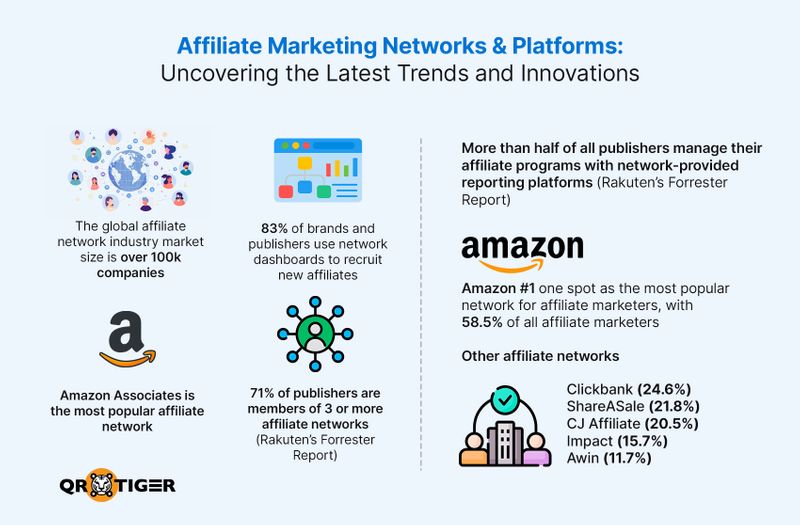Affiliate Marketing in 2025: Data-Driven Trends and Statistics
Affiliate Marketing in 2025: Data-Driven Trends and Statistics

Introduction
Affiliate marketing has evolved from a niche tactic into a $17+ billion global industry that's embraced by over 80% of brands and 84% of publishers. In 2025, this growth shows no sign of slowing – in fact, affiliate marketing is projected to reach $37+ billion by 2025 and climb toward $48 billion by 2027. Such expansion is driven by its proven effectiveness: affiliate programs drive 16% of all online orders in the U.S. and deliver an average return on ad spend (ROAS) of 12:1 for businesses.
For affiliate marketers and content creators, these trends mean more opportunities to monetize content and earn commissions. For businesses launching or managing affiliate programs, it means greater potential to acquire customers and increase sales through partnerships. But taking full advantage requires staying informed and adapting to the latest strategies.
In this article, we'll delve into data-driven insights and industry benchmarks that matter in 2025. You'll discover how to recruit and motivate high-quality affiliates, which emerging trends (like AI and micro-influencers) are shaping the landscape, and how to optimize your affiliate program for maximum ROI – all presented in a credible, SEO-optimized format.
Whether you're a blogger looking to boost passive income or a brand manager aiming to scale your affiliate program, use this guide as your playbook for affiliate marketing success in 2025.
Let's start by examining the current state of affiliate marketing with key statistics, then explore actionable strategies for both affiliates and program managers.
The State of Affiliate Marketing in 2025: Key Stats & Trends
Affiliate marketing is now a cornerstone of digital commerce, with an estimated 80% of brands running an affiliate program. If that sounds high, consider that affiliate partnerships drive between 5% and 25% of total online sales for major brands, making it a vital revenue channel. In fact, a recent survey found 40% of U.S. retailers name affiliate programs as their top customer acquisition method. With such impact, it's no surprise that over 83% of marketers use affiliate marketing to increase brand awareness and 65% of retailers credit affiliates for boosting revenues by 20% or more as mentioned in rewardful.com.
Some eye-opening statistics paint the picture of affiliate marketing's influence and growth:
Market Growth
Global affiliate marketing spend reached $15.7 billion in 2023 and is forecasted to hit $21+ billion in 2024, en route to nearly $37 billion by 2030. In the U.S. alone, annual affiliate spend surpassed $9.5 billion in 2023 and is climbing with double-digit growth each year. This sustained ~10% annual growth rate since 2015 underscores that affiliate marketing is a long-term growth play, not a passing fad.
Adoption & Reach
81% of advertisers and 84% of publishers (bloggers, media sites, etc.) engage in affiliate marketing today. Roughly 80% of brands have some form of affiliate program, spanning every niche from fashion and beauty to tech and finance. Notably, 31% of web publishers now rely on affiliate marketing as their main income source – a testament to how integral it has become for content monetization.
Affiliate-Driven Sales
As mentioned, affiliate referrals account for 16% of all e-commerce orders in the U.S. For some companies, affiliate partnerships contribute an even larger share of revenue – about 23.9% of businesses say 11-20% of their marketing-driven revenue comes from affiliate sales, with some reporting even higher percentages. In essence, affiliate marketing can drive roughly 1 out of every 6 online sales, a substantial piece of the pie.
Return on Investment
Affiliate marketing offers one of the best ROIs among digital channels. Rakuten's data shows an average of $12 in revenue for every $1 spent on affiliate marketing – that's a 1200% ROI. Other sources such as affiliatewp.com report a similar 14x return (1400%). This high ROI stems from the performance-based model: you generally pay commissions on actual sales or leads, making it a cost-efficient, low-risk spend. No wonder 17% of brands now devote 80%+ of their marketing budget to affiliates.
Consumer Influence
Affiliate marketing's effectiveness ties closely to consumer trust in recommendations. 88% of consumers have been inspired to purchase by an influencer's recommendation, and 9 out of 10 shoppers rely on online reviews when making decisions according to optinmonster.com. Great affiliates often double as influencers or subject-matter experts whose content (reviews, tutorials, social posts) carries weight with audiences. This trust factor is gold for conversion rates – it's like word-of-mouth at internet scale.
Content Creators & Influencers Join In
The rise of the creator economy has further fueled affiliate marketing. More than half (58%) of U.S. content creators now earn income from affiliate links, making it the second most popular revenue stream for creators after sponsored content. In fact, in the first half of 2023, 58% of all new publishers joining a major affiliate network (Awin) were influencers integrating affiliate deals into their monetization mix. The lines between "affiliate marketer" and "influencer" have blurred – many influencers use affiliate links to monetize their recommendations, and many affiliates build influential personal brands. Both paths lead to the same result: trusted voices driving sales and earning commissions.
Top Affiliate Verticals
Affiliates operate in virtually every industry, but some niches dominate in terms of program prevalence and profit potential. Fashion is the single largest affiliate vertical, accounting for ~25% of affiliate programs. Other lucrative niches include health & wellness (a $6 trillion market), technology & gadgets, personal finance, and hobbies/leisure, all of which offer high consumer demand and plenty of products to promote. Notably, affiliate marketers in certain niches can earn exceptional incomes – e.g., the finance niche sees average affiliate earnings around $9,300/month, and tech around $7,400/month. By contrast, niches like arts & crafts or pet supplies tend to have lower earnings (under $1,100/month on average). This doesn't mean you can't succeed in smaller niches (in fact, less competition can be an advantage), but it highlights where a lot of affiliate money flows in 2025.

Affiliate Platforms & Networks
Most brands don't run affiliate programs entirely alone – 83% of businesses use affiliate networks or SaaS platforms to manage recruitment and tracking (Rakuten/Forrester). These networks (like Amazon Associates, ShareASale, CJ, Impact, etc.) provide a ready pool of affiliates and tools. Amazon's affiliate program is by far the largest, with ~900,000 active affiliates and an estimated 58.5% of affiliate marketers participating. Other major networks each command smaller slices (e.g., ClickBank ~25%, ShareASale ~22%, CJ ~20%, Impact ~16%, Awin ~12%). Publishers also tend to multi-home: 71% of affiliate publishers belong to three or more networks, giving them access to a wide range of offers. For businesses, listing your program on popular networks or directories (like FindAffiliates, an affiliate program directory) can substantially widen your reach to prospective partners.
Traffic & Marketing Channels
SEO (Search Engine Optimization) remains the #1 traffic source for affiliates, with around 70–78% of affiliate marketers relying on organic search to drive visitors to their content. Ranking high on Google for product reviews or "best X" comparisons is incredibly valuable for affiliate conversions. Social media is the second-biggest channel – about 65-67% of affiliates use social platforms like Facebook, Instagram, or YouTube to engage audiences. Blogging (content marketing) closely follows, used by ~65% as well. Email marketing and paid advertising (PPC) are also in the mix but less common across the board. Mobile traffic is huge too: roughly 50% of affiliate-referred traffic now comes from mobile devices, so both affiliate content and merchant landing pages must be mobile-friendly for success.
Technology & Automation
One of the biggest shifts in 2025 is the mainstream adoption of AI tools among affiliate marketers. Over 79% of affiliates report using AI-driven content creation tools – from AI writers that draft product descriptions to AI image generators for blog graphics – to increase productivity. Additionally, affiliates and program managers alike are using advanced tracking software, attribution tools, and analytics dashboards to optimize performance. The arms race for efficiency has even led to dedicated AI-powered affiliate platforms that help match influencers to products. Embracing these technologies (while still adding human creativity and insight) can give you a competitive edge.
Conclusion
In summary, affiliate marketing in 2025 is bigger and more competitive than ever, yet full of opportunity. Both the data and real-world outcomes affirm its value. For example, when one online retailer overhauled its affiliate strategy with better partnerships and tracking, it saw an +85% surge in affiliate-driven orders, dramatically boosting sales. Brands are doubling down on affiliate partnerships, and creators are flocking to this income stream. To capitalize, you need to align with the latest trends shaping the industry and implement best practices whether you're promoting products or managing a program.
Affiliate marketing is booming in 2025, driven by exceptional ROI and expanding digital influence. By staying informed of industry trends, marketers and businesses can effectively leverage affiliate programs for sustainable growth.